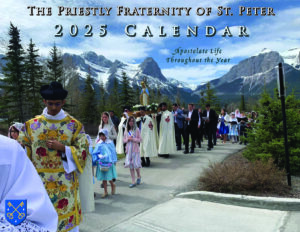September Ember Days
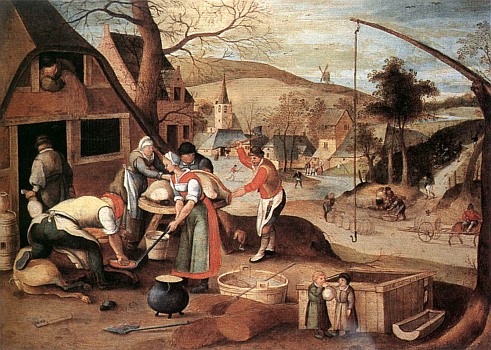
By Fr. Chad Ripperger, FSSP
Wednesday, Friday, and Saturday after the Feast of the Exaltation of the Holy Cross, September 14th, are known as “Michaelmas Embertide,” and they come near the beginning of Autumn (September 22nd) and were formerly set aside as days of fasting and abstinence. The Lessons focus on the Old Covenant’s Day of Atonement and the fast of the seventh month, but start off with this prophecy from Amos 9:13-15 :
Behold the days come, when the ploughman shall overtake the reaper, and the treader of grapes him that soweth seed, and the mountains shall dop sweetness, and every hill shall be tilled. And I will bring back the captivity of My people Israel, and they shall build the abandoned cities, and inhabit them; and they shall plant vineyards, and drink the wine of them; and shall make gardens and eat the fruits of them; and I will plant them upon their land: and I will no more pluck them out of their land which I have given them; saith the Lord thy God.
Like all Embertides but Whit Embertide, the Lessons end with the story of the three boys in the fiery furnace, as told by Daniel. The Gospel readings recount how Jesus exorcised demons from a possessed boy and tells the disciples about fasting to cast out unclean spirits (Matthew 9:16-28), forgave Mary Magdalen (Luke 7:36-50), and healed the woman on the sabbath after telling the parable of the fig tree (Luke 13:6-17). In the midst of this beautiful time, things wizen and seem to begin to die. The air grows cooler, the earth stiffens, the trees tire of holding their leaves. And during this waning we remember our dead — on November 1st, the victorious dead (All Saints’, or All Hallows Day), and on November 2nd, the dead being purified (All Souls’ Day). These Days of the Dead begin with the eve of All Hallows, or “Hallowe’en,” an unofficial evening of remembering the frightening fate of the damned and how we can avoid it. There can’t be a more appropriate time for such a night than Autumn, when foggy mists are likely, and bonfires helpful.
September 24, 2009
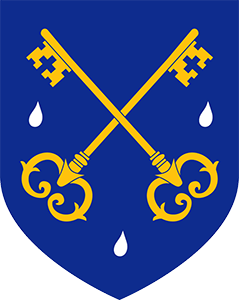
Elysburg Carmelites Enclosed
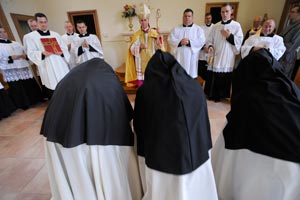
The Discalced Carmelites, mentioned in a previous article, were enclosed in their Elysburg convent on August 25th, 2009. This event joyfully took place on the 447th anniversary of St. Theresa of Jesus founding of her first reformed Carmelite convent. The Priestly Fraternity of Saint Peter has been very involved with the sisters since their founding in the Diocese of Lincoln, Nebraska.
Fr. Joseph Howard, FSSP celebrated a Solemn High Mass with many faithful present, including Bishop Kevin Rhoades of the Diocese of Harrisburg. The nuns relocated due to an increase of vocations. Fr. Howard will be the chaplain for the sisters and will provide daily Mass for the convent.
A detailed article along with photos, originally published in the Catholic Witness, may be read on the Diocese of Harrisburg website.
Prayer intentions can be sent to the Carmel of Jesus, Mary, and Joseph at 430 Monastery Rd., Elysburg, Pa., 17824 or given via phone at 570-672-2122.
For more information go to:
September 22, 2009

Seminary Chapel Progress – September 2009
Our new chapel at Our Lady of Guadalupe is coming along nicely. We thank all of our benefactors for their generous support. Please take a moment to view our progress this month.
If you would like to help financially with this project, please go to our Contributions Page. Thank you and may God reward you!
September 16, 2009

Our Lord Jesus Christ’s Testimony of Himself as the Messiah
 by Fr. James B. Buckley, FSSP
by Fr. James B. Buckley, FSSP
(From the August 2009 Newsletter)
Pope Saint Pius X condemned the proposition that “Jesus when He was exercising His ministry did not speak for the purpose of teaching that He is the Messiah…” (Denzinger 2008).
The pope’s condemnation can be verified from an examination of the four Gospels. Besides calling Himself the Son of man, a messianic title, He assented when Caiphas asked if He was “the Christ, the Son of God” (Matt. 26:64), told Pontius Pilate that He was a king but His kingdom was not of this world (John 18:36), and answered the Samaritan woman who spoke of the coming Messiah, “I am He” (John 4:26).
In addition to these well-known examples, there are several others which prove that during His public life Jesus taught that He is the Messiah. First of all, Catholics know that at Cesarea Philippi our Lord asked His apostles, “Whom do you say I am?” Peter replied, “You are the Christ, the Son of the living God.” Approving this answer, Jesus said, “Blessed art thou Simon Bar Jona: Because flesh and blood hath not revealed it to thee, but my Father who is in heaven” (Matt. 16:17).
He teaches the disciples of John the same truth. While their master was in prison, a delegation of them came to Jesus in an effort to find out if He was the Messiah. “Are you the one who is to come,” they asked, “or do we look for another?” Jesus replied, “Go and relate to John what you have heard and seen. The blind see, the lame walk, the lepers are cleansed, the deaf hear…” (Matt. 11:3–6). This answer is evidently an affirmation. What makes it even more striking is that Isaias, after foretelling that “God himself will come to save you,” prophesies: “then shall the eyes of the blind be opened, and the ears of the deaf shall be unstopped. Then shall the lame man leap as a hart and the tongue of the dumb shall be free” (Isaias 35:4–6).
Saint Luke records that after His temptations in the desert our Lord went to the synagogue in Nazareth where on the Sabbath He read from Isaias 61:1: “The Spirit of the Lord is upon me. Wherefore he hath anointed me to preach the gospel to the poor…” He then announced to the congregation: “This day is fulfilled the scripture in your hearing” (Luke 4:21). By these words He implied that He was the Messiah sent by God to evangelize the poor.
In chapter 12 of Saint Matthew’s Gospel, moreover, there are repeated statements in which Jesus all but explicitly declares that He is the Messiah. Referring to Himself, He says: “But I tell you that there is here a greater than the temple.” Speaking again of Himself, He says: “For the Son of man is greater that the Sabbath.” Then, comparing Himself to the prophet Jonas, He proclaims, “Behold a greater than Jonas is here.” And although Solomon was regarded as the wisest of the kings of Israel, Jesus announces: “Behold, a greater than Solomon is here.”
The evidence already presented more than suffices to justify Pope Pius X’s condemnation; nevertheless, I will include a few statements recorded by Saint John which demonstrate that our Lord claimed not only to be the promised Messiah but also God Himself. In one altercation with the Pharisees, for example, He said: “Amen, amen I say to you, before Abraham was made, I am” (John 8:58). At another time He told the unbelieving Jews: “I and the Father are one” (John 10:30). When the apostle Phillip asked Him “show us the Father,” Jesus answered: “Phillip, he that seeth me seeth the Father…Believe you not that I am in the Father and the Father in me?” (John 14:8–10).
Because of our Lord’s sanctity, His own testimony of Himself is a powerful proof that He is, at least, the legate of God. His miracles, His unerring prophecies and the prophecies that He Himself fulfilled provide overwhelming proof that He is, indeed, the Expectation of the nations.
August 26, 2009

Confraternity Pilgrimage – Italy, France, & Bavaria
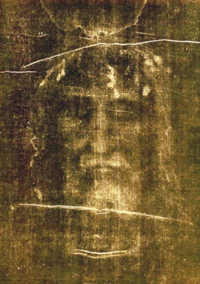
Come along May 17-27, 2010 with Father Neal Nichols, FSSP as the Confraternity of Saint Peter travels to historic and sacred Italy, France, and Bavaria to commemorate the Year of the Priest. On this trip you will be blessed to visit the following places:
- Shroud of Turin Exposition (of the 6th exhibition since 1898)
- Saint Don Bosco
- Laus & La Salette
- Grand Chartreuse Abbey
- Ars
- Paray La Monial
- Oberamergau Passion Play (performed every decade since 1634)
For more details call Syversen Touring at 1(800)334- 5425 or go to www.syversentouring.com/ars
August 19, 2009

Confraternity Pilgrimage – California Missions
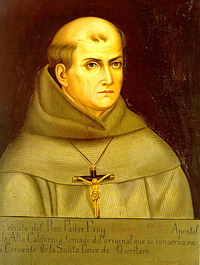
Come along October 19-27, 2009 with Father James Fryar, FSSP as the Confraternity of Saint Peter travels to the historic California Missions. On this trip you will be blessed to visit the following places:
- 12 Historic California Missions
- Miracle Swallows of Capistrano
- Danish Village of Solvang
- St. Thomas Aquinas College’s new chapel
- California’s beautiful coastline
- Sonoma Cline Winery & Mission Museum
All-inclusive land cost: $1995 from San Deigo. To download a brochure, go to www.syversentouring.com/confraternity/
For more details, call Tish Gallagher at 1 (916) 223-3112 or Syversen Touring at 1(800) 334-5425

Pragmatism by D.Q. McInerny, Ph.D.
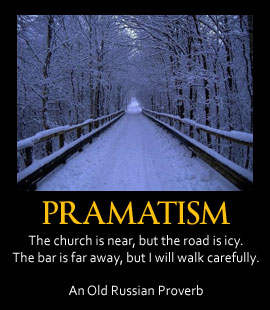 (From the August 2009 Fraternity Newsletter)
(From the August 2009 Fraternity Newsletter)
Most of us would be prepared, I suspect, to see something to admire in what was presented to us as a pragmatic approach to life, that is, the kind of approach taken by someone who has a clear-eyed sense of a job to be done, a goal to be reached, and then forthrightly chooses the most efficient means to do that job or reach that goal. By and large, we are inclined to praise those we regard as practical people, whereas the adjective “impractical” is almost never applied by way of a compliment. Impractical people might make nice company in relaxed social situations—because, say, they are witty, or sprightly conversationalists, or good listeners—but we would be reluctant to pick them as our helpers in the kitchen or workshop.
Of course, it’s a bit simplistic to suggest that the world can be neatly divided into practical and impractical people, as if a person were purely the one or the other. Most of us are admixtures of both the practical and the impractical, and which of these two dimensions of our personalities might come to the fore varies over time. We have our good days, when we match means to ends with a facility which might surprise even ourselves, accomplishing all sorts of things with the greatest of ease. Then there are those days when we seem to be all thumbs, and none of our projects are brought to completion, or, if they are, only in a droopy, unimpressive way.
Could we say that pragmatism, or practicality, is a virtue? Well, not just as such, but we could regard it as an element of the virtue of prudence, that queen of the moral virtues which is our sure guide in leading us to what is truly good for our total welfare as rational creatures made in the image and likeness of God. If the heart of practicality is choosing the most efficient means to attain an end, then whether or not the exercise of our practicality in any given instance is worthy of praise would all depend upon the moral quality of the end we are pursuing, as well as on the moral quality of the means we employ to achieve that end. And there is the critically important point, a point which, unfortunately, would seem to be lost on many people today. We live at a time when expediency rules, sometimes an expediency of the crudest kind. I speak of an attitude that systematically ignores the moral quality of ends and means, and blindly exercises a practicality which is thoroughly barren because it is completely at odds with virtue. Let us state the case plainly: there is no merit in being practical if our practicality is not in the service of the good.
Americans tend to pride themselves on being a practical people, and I suppose in certain respects there is some justification for considering ourselves to be such, for better or for worse. But whether Americans are more practical than any other people you could name—the Chinese, for example—is an arguable point. What isn’t arguable is the noteworthy fact that Americans have provided the world with a distinct theoretical articulation of the pragmatic approach to life, taking the form of the one philosophy which is indigenous to this country, a philosophy which is called, fittingly enough, pragmatism. The three American philosophers whose names are most closely associated with this philosophy are Charles Sanders Peirce (1839–1914), William James (1842–1910), and John Dewey (1859–1952). Pragmatism, in not a few of its features, is an interesting philosophy, and it has some positive aspects to it. It is also, in my opinion, a philosophy which is quite revealing of the general tone of the culture of the country from which it emerged. But, taken as a whole, that is, as a philosophy, pragmatism is fatally flawed. In fact, it can be called a false philosophy.
Why does it deserve so harsh an indictment? Because of its profound confusion over something which is of the greatest consequence, something which it should be the principal business of philosophy to be as clear as possible about—the truth. Considered in the broadest and most fundamental terms, the truth can be understood simply as what is, objective reality, the way things actually are, which the human mind, if it is functioning correctly, strives at every turn to be measured by. The egregious mistake made by pragmatism is to regard truth as simply what works. Truth ceases to be something which is firmly grounded in the objective order, the standard by which the human mind is shaped and directed, and is reduced to a purely functional status. Most importantly, truth, for the pragmatist, is an essentially subjective phenomenon. The idea that there is the truth goes by the board. Truth becomes fluid, ever subject to change, for what worked yesterday may not work today, and tomorrow’s truth will very likely render today’s truth obsolete. Given the subjectivism which underlies the pragmatic understanding of truth, the door is then flung wide open to relativism. What works for you in the moral realm may not work for me, and vice versa, and thus we no longer live in a unified, coherent ethical universe. We do not have a shared moral language.
The attitude toward truth promoted and fostered by philosophical pragmatism is prevalent, if not dominant, today, especially in the political domain, and this is the case not only in America but in Western culture in general, and beyond. We have become pragmatists in the worst possible sense. We forge ahead in madcap fashion to implement plans and policies regardless of their moral quality. The only consideration is, Will they work? Will they be effective in bringing about the changes we want to bring about? This is bankrupt practicality; this is practicality gone berserk. The fact that moral questions are seldom raised, or, seemingly, even entertained, shows the depth and seriousness of our moral obtuseness, not to say degradation. Our mindless pragmatism has succeeded in effectively de-humanizing us. We have become a very efficient people—we can murder babies by the millions, and with the most up-to-date procedures—but we have managed to lose our souls in the process, for we have set our faces against the truth. But the truth will not be trifled with. We may delude ourselves into thinking that we can reconstitute reality according to our own tragically impoverished specifications, but it is always the case that reality, not man’s lying version of it, will triumph in the end. And as history has often shown, when truth eventually triumphs, it crushes those who sought to abuse it.
August 9, 2009

Seminary Chapel Progress – August 2009
Progress on our chapel is progressing steadily. Thank you to all of our benefactors who are making this project possible! Below is an updated photo album as of August 2009.
August 7, 2009

20th Anniversary Rome Pilgrimage 2008
This is a small photo gallery from our Rome Pilgrimage last year, celebrating our 20th anniversary.
August 4, 2009

Fr. Berg on the Year for Priests

This interior renewal of all priests is very important to the life of the Church, to the health of the whole Mystical Body. In the face of continued secularization and its rejection of God and the supernatural life, a corresponding lack of understanding and appreciation of the priesthood has inevitably developed. This has become immediately and unfortunately clear in the first reaction to the ‘Year for Priests’ by some, who have used it as an opportunity to speak out against such constitutive elements of the priesthood as celibacy and the office of governing.
In this atmosphere of negativity and confusion there is the heightened danger for the priest himself of losing his sense of identity as a priest. In his address to the Congregation for Clergy, where he first announced the ‘Year for Priests,’ the Holy Father alludes to just such a threat of ‘undervaluing the ministerial priesthood’: “The centrality of Christ brings with it the correct appreciation of the ministerial priesthood, without which neither the Eucharist nor, consequently, the mission and the Church herself would exist. In this connection it is necessary to watch so that the ‘new structures’ of pastoral organizations are not thought out for a time in which the ordained ministry is ‘undervalued,’ starting from an erroneous interpretation of the correct promotion of the laity, because in such a case the premises would be established for an ultimate dissolution of the ministerial priesthood and the eventual presumed ‘solutions’ would coincide dramatically with the real causes of the current problems linked to the ministry.”
All too often, wherever it finds a distinction between men, this secularized world tends to try to cultivate a state of continual class warfare or at least seeks to introduce the specter of ongoing status-rivalry. It posits struggles between men and women, employer versus employee, and even the laity against the priest as if everything could be reduced to a struggle for power.
Unfortunately, this perspective has encouraged some erroneously to conclude (either implicitly or explicitly) that the best way to underline the dignity of the laity is by diminishing the character of the priesthood in its three offices of teaching, sanctifying and governing. This is to reduce the relation of priest and laity to a conflict about subordination, ignoring the corresponding duties and responsibilities in each state which, having been established by Christ in constituting His Church, are in fact fully complementary.
This error is exemplified in the general practical reaction to the attempt of Vatican II to address the situation of the Church in the modern world and thus to aid the Church in finding the best means to reassert its voice in a world which had already become dramatically secularized by the 1960s. The actual goal in view was to alert the laity to their particular duty and role within human society and its culture (Lumen Gentium 30, 31). They would exercise an ecclesial service in which, through their own insertion into the world, politicians, lawyers, scientists, doctors and others who determine policy and direction in our society would have an opportunity to encounter in them the truth of the Gospel. In a secularized world very few of these would ever stumble first into a church to hear a sermon from the priest, but all of them would rub shoulders with the Catholic laity in the workplace and general society.
Unfortunately this signally important duty of the laity to bring the faith with them into the proper exercise of their state in life has become too often obscured or altogether forgotten in the scramble for ‘power’. The proper position and contribution of the laity to the life of the Church has been replaced in many minds with an idea that the best way to stress the dignity of the laity is to ‘clericalize’ them, especially within the sanctuary and in the context of the sacred liturgy. Such a simplistic response does nothing to promote understanding either the identity of the priest or the real and important duties of the faithful in the world. If the Church is to have its voice in the current culture it must have faithful clearly and carefully instructed and inspired to serve the Gospel by the way they live their lives in accord with their duties of state instead of being encouraged to evaluate their value as dependent on the attainment of elements proper to the clerical state.
The model for the priest offered by the Holy Father in this year is of course the patron of parish priests, St. John Marie Vianney, who spoke often to his flock about the great gift of the priesthood: “A good shepherd, a pastor after God’s heart, is the greatest treasure which the good Lord can grant to a parish, and one of the most precious gifts of divine mercy.” He stressed the priesthood as essential to the salvation of souls: “Without the priest, the passion and death of our Lord would be of no avail. It is the priest who continues the work of redemption on earth.” Finally, he marveled at the gift which he himself had received: “If the priest really knew what he was, he would die, not of fear, but of love.”
With all of this in mind, it seems especially opportune this year to speak about priestly identity. Just before the moment of his ordination the bishop exhorts the young man to do precisely this throughout his priesthood: Agnoscite quod agitis; imitamini quod tractatis; quatenus mortis Dominicae mysterium celebrantes, mortificare membra vestra a vitiis et concupiscentiis omnibus procuretis. “Understand that which you do; imitate that which you treat; as you celebrate the mystery of the death of the Lord, look to mortify yourself from all vice and every evil desire”
Given that “the object of the Fraternity of St. Peter is the sanctification of priests through the exercise of the priesthood, and in particular, to turn the life of the priest towards that which is essentially his raison d’être” (Constitutions, 7), it seems only fitting for the Fraternity to offer a small contribution in celebrating this year by providing sources which will help in the work of deepening our knowledge of the priesthood in order to promote a clearer understanding of this immense gift and thereby to encourage the corresponding response of generosity that it demands of the ordained.
Our Seminary in Wigratzbad will begin the academic year with a pilgrimage and Mass at the tomb of the Holy Curé of Ars in September. Along with other sources which we hope will be an aid for priests throughout the course of this year we would like to provide a series of meditations on aspects of the priesthood which Pope Benedict XVI himself emphasizes in his Apostolic Letter proclaiming the ‘Year for Priests.’ These aspects will be especially considered in light of the life of St. John Marie Vianney.
July-August : The office of sanctifying: the Mass and Confession
September-October : The office of teaching
November-December : The office of governing
January-February : The priest and poverty
March-April : The priest and chastity
May-June : The priest and obedience
May this series provide encouragement to the members of the Confraternity of St. Peter and all the faithful for pray ardently for priests. Most of all we hope that it will be a small aid to priests in understanding the riches of their vocation to bring about the “interior renewal” hoped for by the Holy Father, and the imitation of the Sacred Heart of Christ, the one High Priest. “For in the end, God is the only richness that men wish to find in a priest” (Benedict XVI, address to Cong. for Clergy).
June 19, 2009, Feast of the Most Sacred Heart, Opening of the Year for Priests
Very Rev. Fr John Berg
Superior General
July 8, 2009








